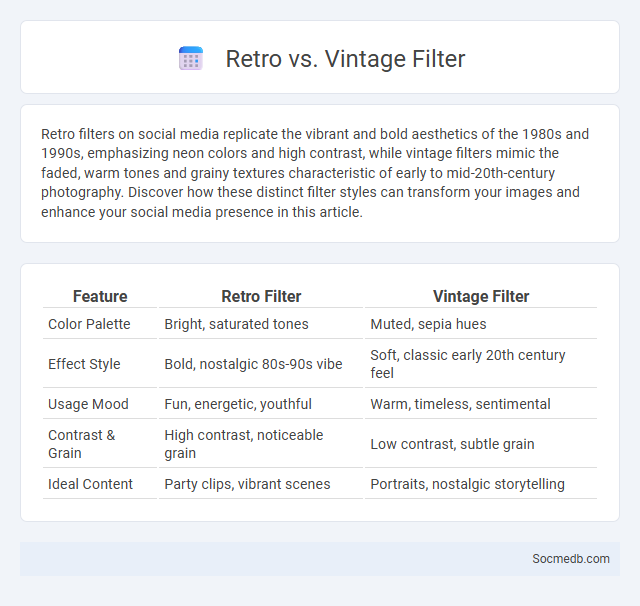
Photo illustration: Retro vs Vintage Filter
Retro filters on social media replicate the vibrant and bold aesthetics of the 1980s and 1990s, emphasizing neon colors and high contrast, while vintage filters mimic the faded, warm tones and grainy textures characteristic of early to mid-20th-century photography. Discover how these distinct filter styles can transform your images and enhance your social media presence in this article.
Table of Comparison
| Feature | Retro Filter | Vintage Filter |
|---|---|---|
| Color Palette | Bright, saturated tones | Muted, sepia hues |
| Effect Style | Bold, nostalgic 80s-90s vibe | Soft, classic early 20th century feel |
| Usage Mood | Fun, energetic, youthful | Warm, timeless, sentimental |
| Contrast & Grain | High contrast, noticeable grain | Low contrast, subtle grain |
| Ideal Content | Party clips, vibrant scenes | Portraits, nostalgic storytelling |
Understanding Retro, Vintage, and Regular Filters
Retro, vintage, and regular filters each create unique visual effects that significantly impact your social media content's mood and engagement. Retro filters often add nostalgic tones and grainy textures reminiscent of past decades, while vintage filters typically emphasize faded colors and warm tints to evoke timeless charm. Regular filters enhance overall image quality by adjusting brightness, contrast, and saturation, allowing you to tailor visuals that resonate with your audience and strengthen your online presence.
Defining Retro Filters: Aesthetic and Appeal
Retro filters recreate the nostalgic look of vintage photography by simulating faded colors, grainy textures, and warm tones that were characteristic of old film cameras. These filters enhance Your social media images by adding a timeless, artistic quality that resonates emotionally with audiences seeking authenticity and charm. Incorporating retro filters boosts engagement by evoking memories and creating a distinct aesthetic that stands out in digital feeds.
What Makes a Filter "Vintage"?
A vintage filter mimics the color tones, grain, and light leaks characteristic of old film photography, often incorporating warm hues, faded contrasts, and subtle vignettes to recreate an aged aesthetic. These filters replicate the imperfections of analog cameras, such as film scratches and muted saturation, giving your photos a nostalgic and timeless feel. When choosing a vintage filter, consider those that enhance your images with authentic retro elements while maintaining clarity and visual appeal.
Key Differences Between Retro and Vintage Filters
Retro filters on social media emulate the look of photographs from the mid-20th century, featuring strong color shifts, high contrast, and grain to capture nostalgic moods. Vintage filters, in contrast, replicate the softer, faded appearance of older film types with muted tones, warm hues, and subtle vignettes for a timeless aesthetic. These differences impact user engagement by appealing to distinct emotional responses, with retro filters often evoking energetic nostalgia and vintage filters suggesting quiet elegance.
The Role of Standard Filters in Modern Photography
Standard filters play a crucial role in modern photography by enhancing image quality and consistency across social media platforms. These filters adjust exposure, contrast, and color balance to create visually appealing photos that align with current aesthetic trends. Your use of standardized filters can significantly boost engagement by ensuring your content stands out in crowded social feeds.
Color Tones and Texture: Comparing Filter Effects
Color tones and texture play a crucial role in shaping the aesthetic and emotional impact of your social media visuals. Filters that enhance warm tones or increase texture sharpness create a vibrant and tactile feel, while cooler tones with softer textures convey calmness and subtlety. Choosing the right filter effect can significantly influence audience engagement by aligning the visual mood with your brand's message.
Popular Apps for Retro and Vintage Filters
Popular apps for retro and vintage filters include VSCO, Afterlight, and Huji Cam, each offering a wide array of customizable effects that emulate classic photography styles. These apps provide tools like grain textures, light leaks, and faded colors that enhance your social media posts with nostalgic aesthetics. You can easily transform modern photos into timeless visuals that resonate with vintage trends, boosting engagement on platforms like Instagram and TikTok.
When to Use Retro vs Vintage vs Regular Filters
Choose retro filters to evoke a nostalgic atmosphere reminiscent of past decades, ideal for photos that emphasize memories or old-school aesthetics. Vintage filters work best for creating a warm, timeless feel with subtle fading and muted tones, perfect for enhancing portraits or lifestyle images with a classic touch. Regular filters suit everyday posts by enhancing colors and sharpness without altering the photo's original vibe, ensuring your content remains authentic and engaging.
Impact on Social Media Engagement
Social media engagement drives brand visibility by increasing interactions such as likes, comments, and shares, which enhance content reach across platforms like Instagram, Facebook, and Twitter. High engagement rates often correlate with improved customer loyalty and trust, fostering stronger community connections and boosting conversion rates. Algorithms prioritize content with substantial engagement, making consistent interaction essential for maximizing organic growth and audience retention.
Choosing the Right Filter for Your Creative Vision
Choosing the right filter on social media enhances the mood and tone of your photos, aligning them perfectly with your creative vision. Filters like warm tones evoke nostalgia, while cool tones add a modern, sleek feel to your content. Your choice of filter impacts engagement by making your images more visually appealing and consistent across platforms.
 socmedb.com
socmedb.com